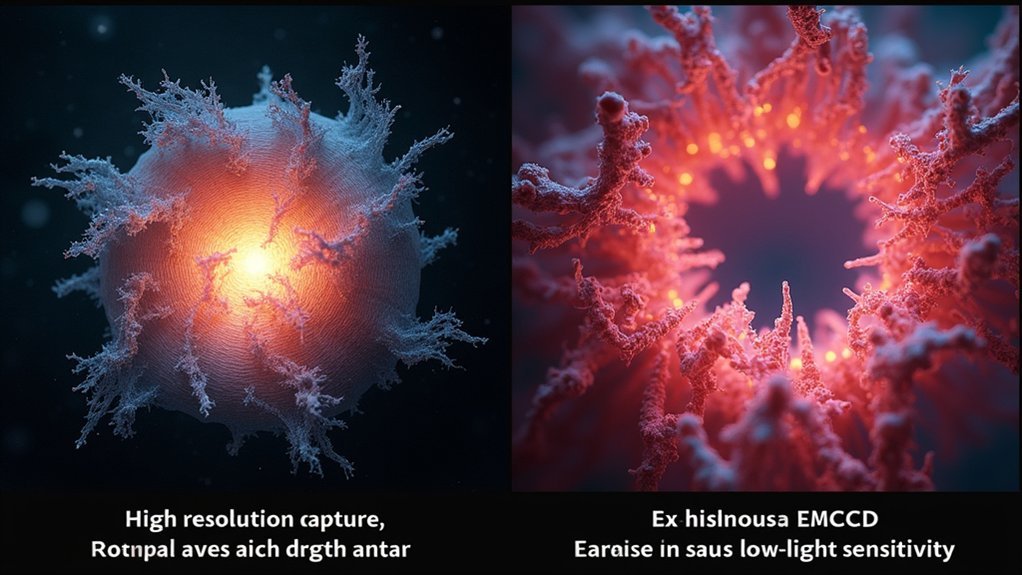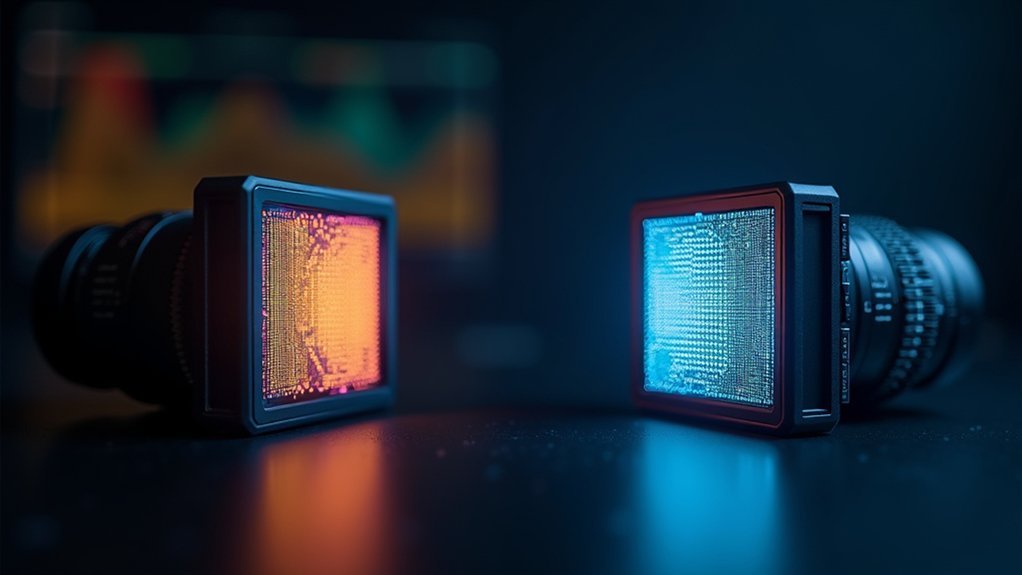EMCCD cameras excel in ultra-low light conditions with superior signal-to-noise ratio, detecting signals as low as 0.1 photons per pixel. sCMOS cameras dominate high-speed imaging, reaching up to 25,000 FPS compared to EMCCD’s 100-150 FPS. Your choice depends on application needs—EMCCD for extreme sensitivity, sCMOS for speed and larger fields of view. Both achieve similar quantum efficiency (95%), but their fundamental technologies create distinct advantages in different scenarios.
Scmos Vs EMCCD: Which Camera Delivers Better Results

When choosing between sCMOS and EMCCD cameras, there’s no one-size-fits-all answer. Your application’s specific requirements should guide your decision.
For ultra-low light conditions where detecting single photons is essential, EMCCD cameras excel with superior signal-to-noise ratio due to their electron multiplication during the readout process. They remain unmatched in applications requiring extreme sensitivity.
Meanwhile, sCMOS cameras dominate high-speed imaging with frame rates up to 25,000 FPS using regions of interest, compared to EMCCD’s 100-150 FPS. Their lower readout noise and high dynamic range make them ideal for brighter fluorescence microscopy applications.
Speed matters in imaging science. sCMOS delivers up to 25,000 FPS where EMCCDs top out at 150 FPS.
Back-illuminated sCMOS options offer larger fields of view, beneficial when you need to capture broader contexts.
Both technologies achieve similar quantum efficiency (95%), but the right choice depends on your specific imaging challenges.
The Science Behind EMCCD and Scmos Camera Technologies
Understanding how these cutting-edge imaging technologies function reveals why each excels in specific applications.
EMCCD cameras utilize electron multiplication to amplify signals before read noise occurs, enabling effective photon counting with extremely weak signals (as low as 0.1 photons/pixel/frame). This gives them superior signal-to-noise ratio in ultra-low light conditions.
In contrast, sCMOS sensors achieve remarkably low read noise (around 0.8 electrons) without amplification, while delivering wider dynamic ranges (up to 37,500:1) and faster frame rates. You’ll get up to 100 FPS at full resolution and 25,000 FPS using regions of interest—significantly outpacing EMCCDs.
The emerging qCMOS technology bridges these approaches, combining EMCCD’s sensitivity with sCMOS advantages, ideal when you need both high resolution and sensitivity across varying exposure times.
Key Performance Metrics: Sensitivity, Speed, and Dynamic Range

While choosing between sCMOS and EMCCD cameras, three critical performance metrics will ultimately determine which technology better suits your specific imaging needs.
For sensitivity, EMCCDs excel with single-photon detection and minimal background noise, achieving read noise of just 0.1 electrons compared to sCMOS cameras’ 1.5-1.8 electrons.
However, you’ll find sCMOS cameras dominate in speed, reaching 100 FPS at full frame and up to 25,000 FPS with ROI, while EMCCDs typically max out at 100-150 FPS with ROI.
Speed is where sCMOS cameras truly shine, delivering frame rates that EMCCDs simply cannot match.
Dynamic range represents another significant difference—sCMOS cameras deliver an impressive 37,500:1 ratio versus traditional CCDs’ 3,000:1.
Both technologies offer comparable quantum efficiency up to 95%, but your specific application—whether high-speed imaging or ultra-low light detection—should guide your final decision.
Single-Molecule Applications: Where Each Camera Type Excels
Now that we’ve examined the fundamental performance metrics, let’s focus on how these translate to real-world single-molecule applications.
EMCCD cameras shine in ultra-low light conditions where their ability to amplify single photoelectron signals by up to 1000x proves invaluable for detecting faint molecules. Their superior sensitivity allows you to track rare events even with minimal photon counts, despite higher dark current limitations.
Scientific CMOS cameras dominate when speed is critical, delivering higher frame rates (up to 100 FPS full-frame and 25,000 FPS with ROI) with efficient pixel readout.
For applications using bright synthetic probes, back-illuminated sCMOS provides both an expanded field of view and better signal-to-noise ratio at higher light levels. This makes them ideal when you’re tracking multiple molecules simultaneously and need spatial detail across the sample.
Real-World Performance in Low Light and Fast Imaging Scenarios

When confronting extreme low-light conditions, the theoretical specifications of cameras translate into measurable practical differences. EMCCD’s multiplying CCD technology excels when detecting fewer than 0.1 photons per pixel, maintaining superior signal-to-noise ratios in ultra-low light scenarios.
However, you’ll find sCMOS cameras dominate fast frame applications, reaching 100 FPS full frame and 25,000 FPS using region of interest settings. They’re particularly valuable in live cell imaging with their 50% larger field of view.
| Parameter | EMCCD | sCMOS |
|---|---|---|
| Low Light | Superior <0.1 photon | Good with lower read noise |
| Speed | Limited | Up to 25,000 FPS with ROI |
| Field of View | Standard | 50% larger |
Choose EMCCD for critical low-light applications, but sCMOS offers better versatility with its high-speed capabilities and performance across varied lighting conditions.
Frequently Asked Questions
What Is the Difference Between EMCCD and Scmos?
EMCCDs offer superior sensitivity in extreme low light with electron multiplication, while sCMOS cameras provide faster frame rates and larger fields of view. You’ll find EMCCDs excel at single-photon detection but sCMOS handles higher speeds better.
What Is the Best Scmos Camera?
The “best” sCMOS camera depends on your specific needs. For quantitative imaging, you’ll appreciate pco.edge 4.2’s ultra-low noise. For life sciences, Sona’s back-illuminated models offer excellent sensitivity and field of view.
Which Is Better CCD or CMOS Camera?
For your specific needs, neither CCD nor CMOS is universally “better.” sCMOS offers lower noise, higher dynamic range, and faster speeds, while CCDs excel in simplicity and smaller data sets for some applications.
What Is the Difference Between EMCCD and Qcmos?
The difference is that EMCCDs use electron multiplication giving them superior performance in extremely low light (<0.1 photons/pixel/frame), while qCMOS offers better photon number resolution and higher dynamic range at slower frame rates.
In Summary
You’ll find both sCMOS and EMCCD cameras have their strengths depending on your specific needs. sCMOS excels in fast imaging with wide fields of view, while EMCCDs remain superior for extremely low-light, single-molecule applications. Consider your experiment’s requirements – sensitivity versus speed, signal-to-noise priorities, and budget constraints – when making your choice. The “better” camera is ultimately the one that best serves your particular research demands.





Leave a Reply